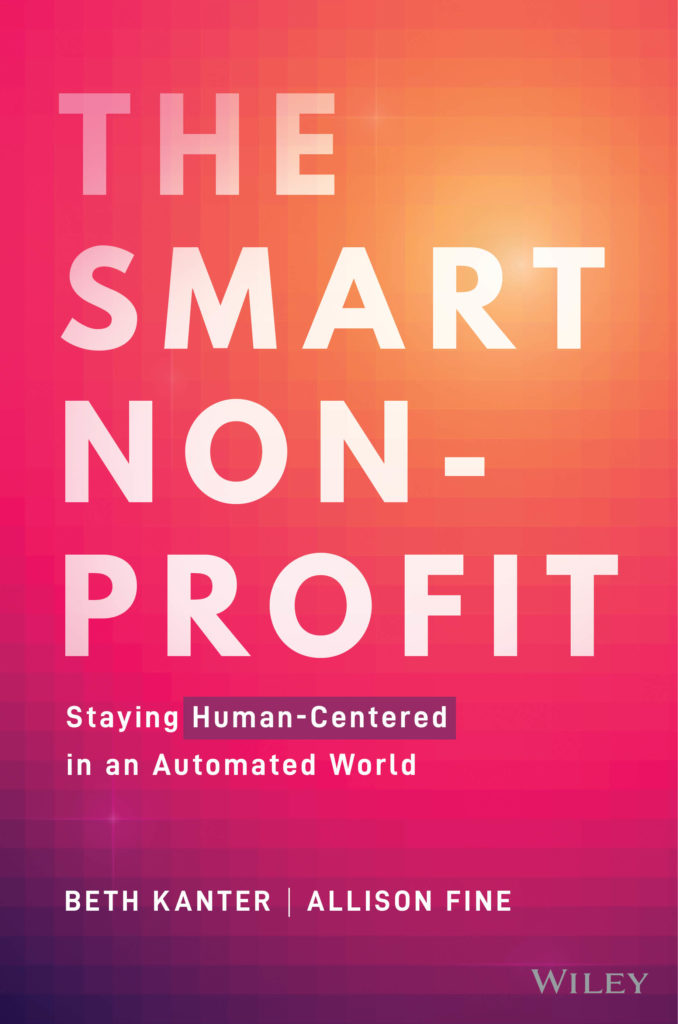What if nonprofits had the time to plan strategically and dream bigger instead of being burdened by repetitive workflows and scarcity mindsets? How can smart technology make this vision a reality? As the tech-enabled world continues to evolve, how can nonprofits harness technology to yield tangible outcomes?
Beth Kanter and Allison Fine explore these questions in their new book, The Smart Nonprofit: Staying Human-Centered in an Age of Automation, a roadmap for understanding how to use smart tech effectively and ethically to reimagine work and accelerate positive social change. We enjoyed speaking with Beth about how nonprofits are creating brighter futures for themselves and their communities – and how your organization can too.
You and Allison Fine recently published your latest book, The Smart Nonprofit: Staying Human-Centered in an Age of Automation. Break it down for those who might know the term, but not exactly what it means: what is smart tech and what does it mean for the nonprofit sector?
We use “smart tech” as an umbrella term for advanced digital technologies that make decisions for people. It includes artificial intelligence (AI) and its subsets and cousins, such as machine learning, natural language processing, smart forms, chatbots, robots, and more.
At many nonprofits, smart tech is becoming integrated into internal workflows, fundraising, communications, finance operations, and service delivery efforts. Smart tech is currently best used for rote tasks, such as reconciling expense reports and answering the same questions online using a chatbot (e.g., “Is my contribution tax-deductible?”) — freeing up staff to focus on other activities. We call this benefit the “dividend of time,” which can be used to, say, reduce staff burnout, get to know clients on a more human level, and focus on deeper societal changes that need to be made, such as addressing the root causes of homelessness, in addition to serving people experiencing homelessness.
How did smart tech and AI (machine learning, natural language processing, smart forms, chatbots, robots, etc.) enable nonprofits to pivot during the pandemic? What operations and service lines did it help them automate?
The pandemic created many disruptions and problems that impacted people living in vulnerable neighborhoods, where nonprofit organizations often provide services. While the pandemic accelerated the need for digital transformation for every sector of our society, nonprofits had to embrace fast-paced digital transformation overnight because, in some cases, it was a life or death matter for the people they serve.
Here are two of our favorite examples from an article we wrote for the Harvard Business Review, How Smart Tech Is Transforming Nonprofits:
- Feeding Children Through School Lunch Programs: When the pandemic began and schools switched to remote learning, many students who relied on school lunches were not able to receive them. Researchers at Carnegie Mellon University used machine learning to flip the system on its head; instead of using buses to deliver children to schools, new bus routes were created to bring meals to children in the Pittsburgh area in the most efficient way.
- Helping with Evictions: The use of chatbots to provide support and deliver services to vulnerable populations increased tremendously during the pandemic. For instance, legal aid nonprofits in Illinois developed the Rentervention chatbot to help tenants navigate eviction and other housing issues they were experiencing due to COVID-19. It also directs renters to pro bono legal advice.
Automation can eliminate exhausting grunt work for staff, freeing them up to focus on building relationships with volunteers and monitoring their activities to improve the experience.
Here at Common Impact, we leverage skills-based volunteering as a tool to strengthen nonprofits’ strategy and operations work, and by extension, their overall success. How can AI serve as a complement to skilled volunteering for nonprofit capacity building?
We did a study for the Bill & Melinda Gates Foundation on the use of smart tech for fundraising, volunteering, and philanthropy called AI4Giving. We came across many examples of using smart tech tools, essentially smart CRMs (customer relationship management systems). For example, Salesforce Nonprofit Cloud has many use cases for volunteer management. Smart tech can match volunteers with opportunities and it does this with a lot of precision, serving up the right volunteer job at the right time with a lot of personalization that is automated. It isn’t just the matching process, but also automating their entire volunteer experience from initial introduction to evaluating experience. The automation can eliminate exhausting grunt work for staff, freeing them up to focus on building relationships with volunteers and monitoring their activities to improve the experience. This can lead to repeat volunteers and avoiding lapses.
Let’s talk about embedded bias. A common belief is that AI is emotionless and impartial, but the truth is that it’s created by people who (oftentimes unknowingly) carry their own biases into their work and rely on limited or flawed data sets. What should nonprofits do to account for and overcome embedded bias in their smart tech so it doesn’t undermine their equity efforts?
Spiderman’s motto, “with great power comes great responsibility,” applies to users of smart tech. Whether you are an executive, team member, consultant, or customer, using smart tech ethically is one of your essential responsibilities. This isn’t about grabbing software off the shelf or delegating the process to the IT department or your technical consultant. This is an all-hands-on-deck process.
Smart tech is not perfect, and that is partly due to a lack of diversity and representation on the teams designing how the technology will be designed and implemented. When development is guided by the needs and values of a small group of insiders who don’t fully understand the end user’s context, the needs of those users and many others are often excluded.
In addition, smart tech implementation also needs to be guided by the organization’s ethical values. This includes the selection of the technology vendors and technology partners. In the book, we recommend that organizations create ethical guidelines (we include examples) and more importantly, an ethical oversight board. With a thoughtful, knowledgeable, reflective, and inclusive approach to adopting smart technology, we can greatly reduce bias and mitigate harm.
We have the opportunity to re-humanize work, but only if nonprofit leaders lean into the adoption of smart tech and take a human-centered approach.
How can smart tech contribute to a more flexible, accessible environment of remote/hybrid work for nonprofit professionals?
Let’s face it: even before the pandemic, nonprofit work sucked. Well, not at every nonprofit, but it is more the norm than the exception. Low pay, long hours, unrealistic workloads, lack of operationalizing work-life balance, and toxic work environments. There was burnout in the sector prior to the pandemic, although it was treated as a taboo topic. (It was one of the reasons why Beth wrote The Happy, Healthy Nonprofit: Strategies for Impact without Burnout in 2016). The pandemic has created the conditions for a workforce crisis in the nonprofit sector due to increased demand for services and staff quitting in the Great Resignation.
We have the opportunity to re-humanize work, but only if nonprofit leaders lean into the adoption of smart tech and take a human-centered approach. I’m not saying that smart tech is some magic fairy dust, but maybe it can inspire positive change. Here’s an article we wrote for HBR that provides more context and more examples.
What does embracing the future of smart tech mean for nonprofit leaders and board members?
As we’ve outlined in our book, smart tech is quickly changing what we do and how we do it. Leadership is required to actively and purposefully create the conditions for people and organizations to thrive. The combination of leadership and smart tech creates the possibility of a very different kind of future if implemented responsibly and ethically.
The work of nonprofit organizations will change. It will hopefully include:
- More time spent getting to know clients, board members, donors, and volunteers – learning who they are and what their needs are; solving clients’ problems before they turn into crises; understanding why your cause is so important to board members, donors, and volunteers.
- Emphasis on solving rather than serving problems. We want more organizations to become great advocates for more money and support for, say, affordable housing, and spend less time turning away enormous numbers of people who need emergency housing.
- Real-time information on what’s working and what isn’t, what services are needed, who needs help, and how to get it to them.
The Smart Nonprofit: Staying Human-Centered in an Automated World is available now.

Beth Kanter is an internationally recognized thought leader and trainer in digital transformation and well-being in the nonprofit workplace. She and Allison Fine previously co-authored the award-winning book The Happy, Healthy Nonprofit: Strategies for Impact without Burnout. Named one of the most influential women in technology by Fast Company and a recipient of the NTEN Lifetime Achievement Award, Beth has over three decades of experience designing and delivering training programs for nonprofits and foundations

Allison Fine is among the nation’s pre-eminent writers and strategists on the use of technology for social good. She is the author of the award-winning Momentum: Igniting Social Change in the Connected Age and Matterness: Fearless Leadership for a Social World and co-author with Beth Kanter of the best-seller The Networked Nonprofit. She is a member of the national board of Women of Reform Judaism and was chair of the national board of NARAL Pro-Choice America Foundation and a founding board member of Civic Hall.



